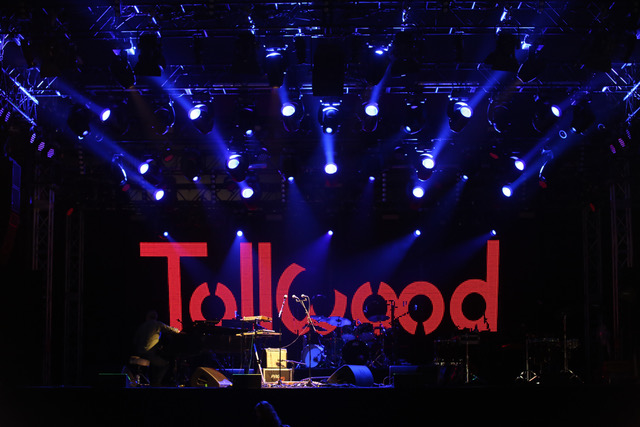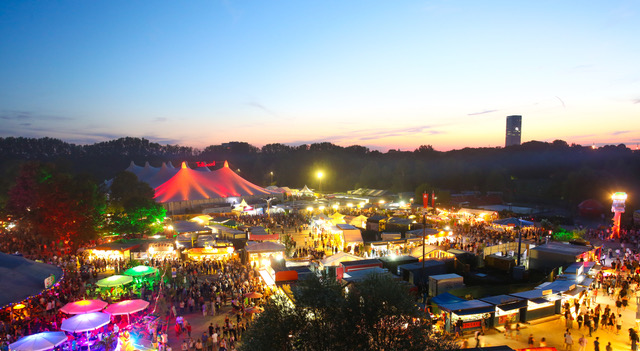Someone in a tri-corner hat, 18th-century jacket and roomy boots sashays up to a hi-vis jacket-clad security guard at the front gate of the Tollwood Festival to ask where the music tent is. A second glance verifies: yes, it is pirate Jack Sparrow. Johnny Depp is due to take the festival stage that evening with fellow Hollywood Vampires Alice Cooper and Joe Perry at the sold-out opening performance. Could it be Depp himself in an impromptu appearance?
Sadly, no. But Philipp Mezger – an astonishingly convincing Jack Sparrow impersonator, even down to the dirt around his fingernails – has arrived from Stuttgart to attend a personal audience with Depp. Totally unfazed, the guard points out the way as another visitor pedals her bike into the festival grounds. “Get off the bike!” the security guard yells. The cyclist shouts over her shoulder that she’s just going to the tent for tickets. Annoyed, the security guard grumbles: “Es ist zum Mäuse melken” (It’s enough to make you milk a mouse.”).
Just about anything goes at Munich’s now long-standing Tollwood Festival. Celebrating its 30th anniversary this year, it has evolved into a cherished fixture of the city’s event calendar, an exponent of Munich’s relaxed, easy-going approach to cultural celebration and leisure. Sprawling across 30,000 m2 of the Olympiapark, the festival features seven event and gastronomy tents and 276 stalls arranged around a random network of alleys and avenues, a bit like a mediaeval city. Over 26 days, Tollwood will present 25 eclectic concerts featuring – apart from the Hollywood Vampires – Billy Idol, Earth, Wind and Fire and Alanis Morissette, as well as Konstantin Wecker and other German and Austrian musicians.
At 2pm on 27 June, the first visitors trickle in like the rainy afternoon. But as the day progresses and the weather gets friendlier, people stream into the festival grounds – most of them repeat visitors from Munich and further afield. Steffi Haberl and Markus Pohnert travel from Pingarten near Regensburg to attend the opening day. “I’ve come frequently in the past,” says Haberl. She enjoys the atmosphere, the variety of stalls, the festival’s location in the Olympiapark. Sabrina, a Munich resident, attending the festival with her friends Johanna and Sebastian, likes the relaxed ambience; she usually attends the festival a couple of times every year.

No one remembers where the name came from. It could have something to do with “toll” (great) “wood”, or was perhaps spun off the legendary Woodstock festival, as Tollwood had its beginnings in the hippie era. “I think there must have been a merry evening” when the founders came up with the name, laughs Christiane Stenzel, Tollwood’s head of PR and spokesperson.
Over the years, Tollwood’s founders have become something like Munich cultural royalty. The festival had its beginnings in a small alternative music venue called Musikalisches Unterholz (musical undergrowth), known affectionately as MUH, which was established by Uwe Kleinschmidt and Rita Rottenwallner, together with Beppi Bachmaier. Kleinschmidt and Rottenwallner then developed the idea to bring together different cultural and artistic forms and present them “on a green field”. They started off in 1988 with one tent and a small market where musicians performed every evening. When asked if their start-up was a political statement, Kleinschmidt countered: “This festival is simply culturally necessary. It shows that alternatives are possible.”
The “alternative” grew into a professional venture combining for-profit and not-for-profit elements to create a sustainable, social and cultural institution. Tollwood expanded over the years, adding a winter festival from 1992 and a number of social projects in collaboration with other NGOs. With “Bio für Kinder”, for example, Tollwood worked together with the city of Munich to spearhead a scheme providing children in schools and daycare with organic meals. The Aktionsbündnis “Artgerechtes München” (campaign alliance for a “species-appropriate Munich”) seeks to establish the city as a place where animals are treated with respect and care. The food served at Tollwood has been certified organic since 2003.

The multicultural ambience and gastronomy at the festival is a huge draw. A woman taking shelter from a brief shower says she prizes the festival for its atmosphere and environmental programmes, as well as the food: “It’s not just Schweinebraten”. Fifty-six food stalls offer international cuisine from at least 13 different countries. Makers of artisan products from all over the world occupy about 220 of the stands; others are operated by ecological and social organisations such as Greenpeace. Of the variety of events on offer, the festival prides itself that 70 percent of them are free – including two performances of Carmina Burana by Catalan company La Fura dels Baus.
Festival director Rottenwallner, who took the helm after the death of her partner Kleinschmidt in 1997, is “very socially and ecologically committed”, states Stenzel. Rottenwallner believes “Geht nicht gibt’s nicht” (there’s no such thing as “it won’t work”). “You just have to consider how it can be done.”
A former Munich resident, Barbara Schäfer, has come from Gröbenzell to attend opening day with her six-year-old grandson, Xaver, because “Today is Granny day”. While he munches a huge chocolate on a stick and looks extremely pleased, she explains she’s been visiting the festival over all its 30 years for the food, the music and the vibe. “It’s changed a lot,” she says. “It was a tiny, alternative fair. Now it’s a big, professional festival.”
Tollwood is at heart a concept. It represents a striving for “tolerance, openness and commitment to a better world”. Is that an optimistic dream when the Bavarian government has made displaying crosses mandatory in public buildings and has vowed to tighten restrictions for migrants and refugees? Some people on the right have used social media to complain about the festival’s ethos. “That only strengthens our resolve in what we do,” says Stenzel. Is she aware of any government officials, such as CSU minister president Markus Söder, who will be visiting the festival? “He’s most welcome to drop in,” she says. It sounds like a dare.



 Please whitelist us to continue reading.
Please whitelist us to continue reading.
Member comments